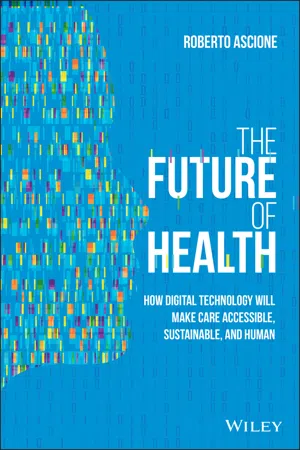
The Future of Health
How Digital Technology Will Make Care Accessible, Sustainable, and Human
- English
- ePUB (mobile friendly)
- Available on iOS & Android
The Future of Health
How Digital Technology Will Make Care Accessible, Sustainable, and Human
About This Book
Learn how the future of medicine is being unlocked—one digital innovation at a time
The Future of Health is an insightful and comprehensive overview of the past, present, and future of digital health. Accomplished health innovation leader Roberto Ascione delivers a practical exploration of how the latest digital technologies are transforming the practice of medicine and redefining health itself by making it more accessible, sustainable, and human.
The book includes practical, real-world examples from the United States, Asia, and Europe of technology applications, companies, and start-up that have changed—or will change—our relationship with our health and the healthcare system. Readers will also find:
- How our health is becoming increasingly consumer and connected while technology is empowering patients in completely new ways and deeply transforming the doctor-patient relationship
- Discussions of how the training of medical professionals, particularly doctors, has changed—or needs to change—to meet the new digital reality
- Examinations of how new technologies will allow doctors to dodge many of the administrative and regulatory burdens they currently face each day
- Treatments of the ability of new technologies to unlock new, holistic ways of practicing medicine, with a focus on latest developments such as Digital Therapeutics and Virtual Reality
- Reflections on how digital health is fostering a shift "from cure to care" and will unleash a human-sized future for a more accessible, ubiquitous, and sustainable healthcare
The Future of Health is required reading for medical practitioners and the managers of pharmaceutical companies. It will also earn a place in the libraries of medical device companies and healthcare entrepreneurs seeking an incisive treatment of the impact of digital technology on all aspects of healthcare. Also, the general public, interested in understanding how to take better control of their own health through digital technologies, will find this book insightful and easy to comprehend.
Frequently asked questions
Information
PART I
Digital Reflections
CHAPTER 1
Devices, Sensors, and Signals
From Wearables to Ingestibles—Toward the Invisibility of Digital Health
Roberto's View
Apple Watch
Table of contents
- Cover
- Table of Contents
- Title Page
- Copyright
- Dedication
- Preface
- Part I: Digital Reflections
- Part II: Human Reflections
- Conclusions: A Radical Shift
- Appendix: Speeches by Roberto Ascione
- About the Author
- About Healthware
- Acknowledgments
- Index
- End User License Agreement